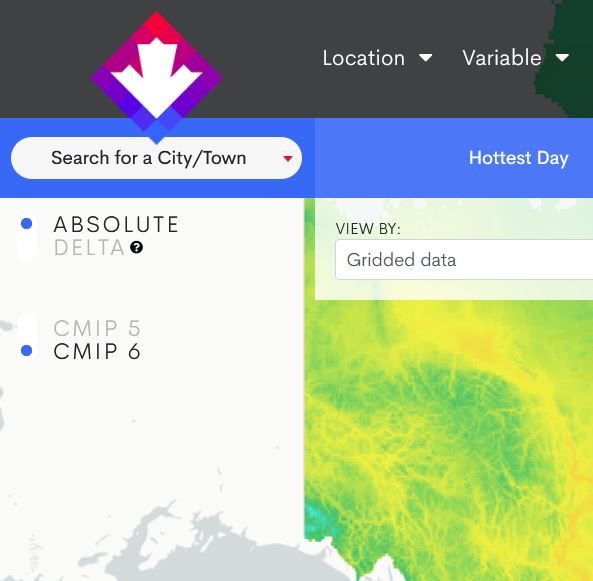If you visit ClimateData.ca right now, all of the data and maps have been updated with new climate model data.
We are excited to announce that the latest phase of the Coupled Model Intercomparison Project (CMIP6) has been added to ClimateData.ca. The CMIP6 data is the most up-to-date global climate model data available and is included in the IPCC’s 6th Assessment Reports.
So, what exactly is CMIP6? And, what makes it different from CMIP5? We’ll take you on a tour of this new dataset, and hopefully answer some of your most pressing questions.
Have some time to learn more?
We’ve compiled a few frequently asked questions on CMIP6 below.
1. What exactly is CMIP6?
The Coupled Model Intercomparison Project (CMIP) is an international scientific collaboration under the United Nations World Climate Research Programme. This initiative involves climate-modelling teams from around the world. CMIP sets the experimental design protocol and recommends core sets of experiments for the climate modelling community to undertake. The goal of CMIP is to generate a set of standard simulations that allows for cross-comparison of results to see where models agree and disagree in order to make improvements and further our understanding of climate modelling.
CMIP6 is the most recently completed phase of collaboration under CMIP. CMIP6 data is the most current global climate model data available. This data is scientifically robust and provides the foundation for the Intergovernmental Panel on Climate Change’s Assessment Reports.
2. Is the CMIP6 data substantially different from CMIP5?
Not that substantially, but there are several differences between CMIP5 and CMIP6 models.
CMIP6 models have increased spatial resolution, representing the atmosphere, oceans and small-scale processes (such as clouds, water vapor, and aerosols) in more detail. This increase in spatial resolution means, among other things, that the representation of extreme precipitation is more realistic. Another notable difference between CMIP5 and CMIP6 is the emissions scenarios used to project future levels of global climate change. Representative Concentration Pathways (RCPs) were used to drive the CMIP5 generation of models. CMIP6 utilizes an enhanced set of emissions scenarios, which are based on Shared Socio-Economic Pathways (SSPs). SSPs complement RCPs by exploring the socio-economic conditions behind various emissions levels in a standardized manner.
There are some additional differences, and you can visit the CMIP6 FAQs to learn more.
3. I’ve heard that some of the CMIP6 models have higher sensitivity. What does this mean?
CMIP6 models generally have a higher spatial resolution and incorporate more physical processes than those in CMIP5. Many of the CMIP6 models are Earth System Models, which include biogeochemical cycles (e.g., the carbon cycle) meaning that they are more complex with more feedbacks and interactions, in particular between the land surface and the atmosphere. These enhancements have resulted in some models having a higher climate sensitivity than their CMIP5 predecessors. In essence, models with higher climate sensitivity project more warming in response to the same forcing than those with lower climate sensitivity. Although some CMIP6 models have a higher climate sensitivity, the range of sensitivities across all models is comparable between CMIP5 and CMIP6 models.
4. Does the release of CMIP6 data mean that the work I completed using CMIP5 data is obsolete and will need to be re-done?
That depends. Although CMIP6 climate models generally include more climate processes, have been run at higher spatial resolutions, and use updated emissions scenarios, there is no such thing as a “perfect” global climate model. Nearly all CMIP6 models build off those used in CMIP5, and CMIP6 model results exhibit many similarities to those of CMIP5.
CMIP5 data are still valid, and can be used to explore possible future climates. Both CMIP5 and CMIP6 rely on emissions scenarios with comparable levels of radiative forcing at the end of the century (2100).
It is recommended, however, that you use CMIP6 for new work requiring future climate projections and that you examine the similarities/differences with CMIP5. Comparing CMIP5 and CMIP6 will indicate if there are significant differences between the two sets of projections and if you need to update any of the work which used projections from CMIP5.
5. I see that future scenarios are now called SSPs. What does that mean?
The scenarios used to characterize possible future development pathways for human societies are now known as Shared Socio-economic Pathways, or SSPs for short. SSPs provide an enhanced understanding of the relationship between socio-economic factors (such as education, population, environmental policy, and more more) and climate change. Since our knowledge of the climate system is constantly evolving, using the most recent set of emissions scenarios means that practitioners can ensure their work reflects the most up-to-date climate information available.
You can learn much more about SSPs, how they are constructed and what makes them different from RCPs (the previous scenarios), by reading our Learning Zone article: Understanding Shared Socio-economic Pathways (SSPs).
Start exploring CMIP6
When you’re ready, head to the ClimateData.ca mapping tool. You’ll find a new selector switch at the top-left of the map that allows you to swap between CMIP5 and CMIP6. By default, the map now shows CMIP6. Can you spot any major differences between the two datasets? Try looking at different time periods and seasons, and of course browse the different variables available too.
We would greatly value your feedback on these new data. You can connect with us at [email protected]. Also, make sure to sign up for our newsletter so you don’t miss future releases. You’ll find the sign-up form at the top of the News page.

